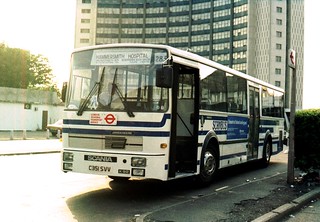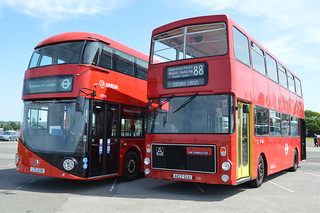This article will be about the more obscure moments of London Buses. The mainstream history of London Buses revolves around the red buses, so I have researched and compiled some of the histories that I've found.
The general public
only knows the London Bus service as the red
bus in London, but there are several oddities when taking a closer look at
the history of London Buses.
Non-red
London Buses
When London Regional
Transport (LRT) privatised the bus routes to competitive tender it enabled
private companies to compete for routes which saw the buses in London come out
in different colours.
The private bus
operators contracted to LRT were not required to have their buses carry LT Red
livery, but they were required to carry a “London
Transport Service” banner to signify a London Bus service.
I have written a
separate article on this topic which you can read here.
What
happened to the real ‘London Buses?'
If you believe that
London Buses are fully owned by TfL then read on for the full story...
When London Regional
Transport was formed in 1984, the Act required that London Buses become a
subsidiary company which was formed in 1985 as London Buses Limited (LBL). Part
of the Act requires bus services to be tendered off to private firms which
required LBL to compete for routes against the private bus operating companies.
The routes were awarded to the company who ran the best service at the most
efficient price.
In April 1989, LBL was
divided into 12 business units in preparation for selling off to private
ownership. The iconic LT red was retained but added in the white relief and
black/grey skirt. Also added in was the modified red and yellow roundel, with
the name 'London Buses' in capitals.
Then in 1994, the
government sold the business units of London
Buses Limited to private companies, but the London Bus Routes continued to
be regulated by London Regional Transport. Also, there were no changes to the
LT fares, Travelcards and concessions, such as the free travel permits for
disabled and elderly people provided by the London council.
In 1999, London
Regional Transport formed East Thames
Buses after the private bus company Harris
Bus went into administration. East Thames Buses was formed because no bus
operating company were in a position to take over operations from Harris Bus.
East Thames Buses operated a small number of routes in London from Belvedere
(BV) and Mandela Way (MA) garages, it represented 1.3% of the London Bus
network. Then on 3rd October 2009, Transport for London sold East Thames
Buses to Go Ahead London General as
they believed it was ‘value for money’
transferring their operations entirely to the private sector.
References:
https://web.archive.org/web/19970111013949/http://www.londontransport.co.uk/facts/factinlb.html
https://web.archive.org/web/19980121151906/http://amdragon.com/londonbuspage/history/index.htm
https://tfl.gov.uk/corporate/about-tfl/culture-and-heritage/londons-transport-a-history/london-buses
https://tfl.gov.uk/info-for/media/press-releases/2008/december/tfl-to-consider-whether-east-thames-buses-could-offer-better-value
Coaches
rebuilt as double deck buses
During 1991, Grey
Green won the tender for the route 141 service (from Wood Green to Moorgate).
As Grey Green was moving from coach operations towards expanding their bus
operations, they decided to rebuild sixteen of their luxury coaches (Volvo
B10M-61) into buses. Seven were single-decks and nine were double decks. The
fleet numbers for the rebuilt double decks were 163-168 and 170-172; you can
view their histories on Ian’s Country Bus website. The liveries for the Grey Green buses
were grey, green and orange stripe.
Here are the photos of
Grey Green 866 (B866XYR)
Double
Decker bus: https://www.flickr.com/photos/kjs251/16143137117/
Quick
note: I linked to the Flickr pages instead of embedding them in this article
due to the publisher’s copyright setting.
References:
http://www.countrybus.org/Volvo/VCGG.htm
http://www.showbus.co.uk/gallery/lt/greygreen2.htm
Nottingham,
Ipswich and South Yorkshire buses operated London Bus routes
During the second half
of 1988, when London Regional Transport tendered off route 188, Boro’line Maidstone won the tender.
Boro’line hired Leyland Atlanteans
from Ipswich Buses and Daimler Fleetlines from Nottingham City Transport because the
new Alexander bodied Volvo Citybuses weren’t delivered on time for the start of
the new contract. The route operated all
the way from Crayford (CR) garage.
Towards the end of
1990, London & Country won the
tender to operate routes 78 and 176. As their order for East-Lancs bodied Volvo Citybus was delayed, this led to London
& Country hiring Leyland Atlanteans and Daimler Fleetlines from South Yorkshire Transport of Sheffield
until their new buses were delivered.
Nottingham City
Transport is still owned by Nottingham City Council but 18% of the stake is
owned by Transdev. Ipswich Buses are still owned by Ipswich Borough Council,
and South Yorkshire Transport was sold to their employees; later it was sold to
First group in 1995.
Photos
of Nottingham City Transport buses in London
Photos
of Ipswich buses in London
Photos
of South Yorkshire Transport buses in London
Route 78
Route 176
References:
http://www.countrybus.org/Volvo/VCKB.htm#fleet
http://www.londonbuses.co.uk/_routes/current/188.html
http://www.countrybus.org/Volvo/VCLC.htm#content
http://www.londonbuses.co.uk/_routes/current/078.html
http://www.londonbuses.co.uk/_routes/current/176.html
A
dual door ‘coach’ used to operate a London Bus route
In 1986, Scanbus
(ScanCoaches) won the contract to operate route 283 with Scania K92 fitted with
Jonckheere Trans-City bodywork. The length of the buses was 12 metres (39ft) as
they were the first full sized buses bought for the London Regional Transport
tendered bus service. Then in mid 1989, Scanbus lost their route 283 contract
to London United, a London Buses subsidiary company.
Commercial Motor has
written a review on the Scanbus service which you can read here.
Images
of Scanbus coaches operating London Buses route 283
References:
http://www.freewebs.com/scancoaches/
http://www.londonbuses.co.uk/_routes/current/283-3.html
A
double decker bus with 2 staircases
I briefly mentioned in
one of my previous articles about the Volvo Alisa V3 (A103SUU). The bus has two staircases and two doors,
one at the front and the other at the rear, its engine is right at the front,
hence the reason the driver has his own cab door.
This bus first spent
its time on Route 77A during the mid 1980’s, it was then confined to route 88.
The problem is, the bus had to carry a conductor because there are blind spots
at the rear door and staircase which the driver is unable to see when
passengers alight the bus at the rear. The bus operated from Stockwell (SW)
garage.
A couple of years
later, the V3 was rebuilt with the rear door removed in favour of extra seats;
the rear staircase was retained. The bus operated on routes from Potters Bar
(PB) garage and received a new livery, retaining the red but with added white
band and black skirt.
In 1992, the bus was
involved in an accident when it turned over and impaled itself on a tree. Then
in 2004, the bus was sold to Black Prince
and it was rebuilt with plum and yellow livery. It saw operation on routes
operated by Black Prince. When Black Prince was sold to First Leeds in 2005 it was retained for preservation and then
transferred to a private owner in the West Midlands and then after that, in
March 2006, to the owner of Blue
Triangle.
The rear door was
restored and it was painted back to their original London Buses livery,
complete with SW garage code. It has since appeared at bus rallies and running
days. When Blue Triangle was bought by Go Ahead, the bus was passed to London Bus Company under the same
owner.
The Volvo Alisa V3
wasn’t the first double deck bus with two staircases; Walsall Corporation
experimented with a Daimler Fleetline
CRC6-36 with Northern Counties body which contained 2 staircases and a dual
door at each end. The registration of the bus is XDH56G and you can read more
about that bus here.
References:
http://www.countrybus.org/Ailsa/V.htm
https://www.flickr.com/photos/britishbuses/16608691608/
https://commons.wikimedia.org/wiki/London_Buses_bus_V3_(A103_SUU)
Prototype
of the Oyster Card during the 1990’s
How time flies! Before
the Oyster card was launched by TfL in 2003, London Regional Transport was
testing the smartcard as part of their proposal, but it was never tested into
passenger use back then.
Here’s a video of the
demonstration of the smartcard, video is by CityTransportInfo
Link to video
Also, during the mid
1990’s, the United States government agency Federal Transit Administration published a report of the smartcard
system proposal for London which you can read here.
Bendy
bus trial under London Regional Transport
If you thought that
the first bendy bus trial was on route 207 back in 2001 in the early years of TfL, then you were wrong.
During the spring of
1992, London Regional Transport leased a Leyland-DAB
articulated bus (fleet code 2001, registration C101HDT) from South Yorkshire Transport of Sheffield.
It operated on route 180 from Abbey Wood to Hither Green station under a short
term trial. Selkent, a London Buses subsidiary company has an interior notice asking for passengers views about
the articulated bus.
Below is the video of
the Leyland-DAB articulated bus in service, uploaded by ‘Beulah23’.
Link to video
Reference:
https://www.flickr.com/photos/46341292@N05/6181761159
I think that covers
most of the 'oddities' of London Buses. However, another oddity is the Capital Citybus’ Tri-Axle
double deck bus which was trialed at the same time as the bendy bus. A short
video can be viewed here.
If I missed out any
oddities then let me know in the comments section and I'll research it and then
update the article.
As always, you can
follow me on Twitter, Tumblr, Pinterest
and Google Plus which is @CLondoner92



